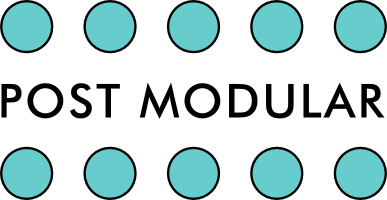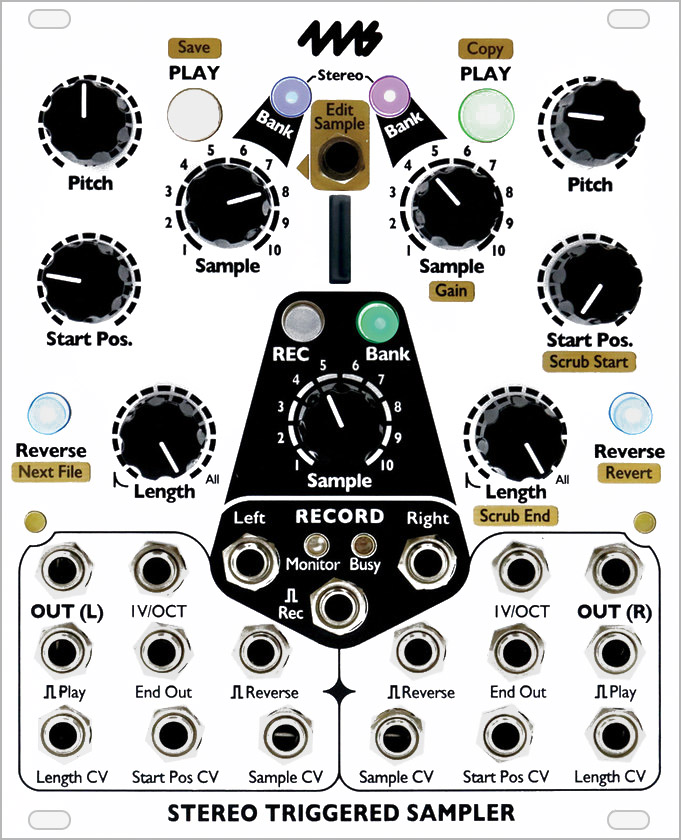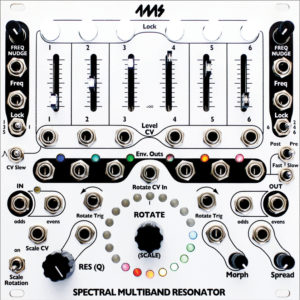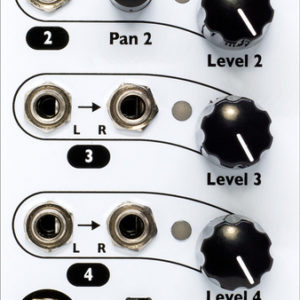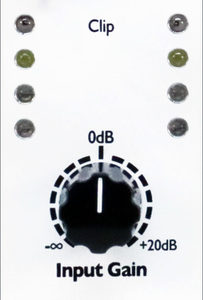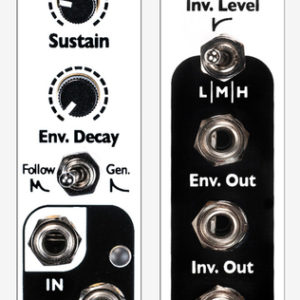Stereo Triggered Sampler
£412.00
2 in stock
Description
The Stereo Triggered Sampler is a high fidelity, two-channel stereo sample recorder and playback module. The STS can record high quality stereo files, while simultaneously playing two different stereo files. A maximum of 600 samples can be loaded from the removable/swappable microSD card, in a variety of formats up to 96kHz/32-bit/stereo WAV. All sample parameters (1V/oct pitch, sample file selection, length, and start position) are CV controllable.
Overview:
A maximum of 600 samples can be loaded at once, arranged into banks of 10 samples each. Samples and banks can be re-arranged on the fly using the simple on-board Edit features. Newly recorded samples can be instantly played back and re-pitched, reversed, chopped up, etc… the result of which can even be bounced down and re-recorded to as a new sample! Sample files are limited to 4GB each, which is over 6 hours at 44k/16b/stereo.
- Hundreds of samples included on microSD card
- Extremely quiet, low noise and low jitter design
- Stereo or Mono operation:
- Stereo mode: Two stereo files are mixed and played through the L and R output jacks (L+L and R+R)
- Mono mode: Each file is mixed to mono and output through the channel’s output jack (L+R and L+R)
- Firmware can be updated by playing an audio file into the STS
Two independent playback channels:
Each playback channel has a knob and CV jack for Sample File selection, as well as a Start Position knob and CV jack for controlling where in the sample playback will begin. The Length knob and CV jack determine how much of the sample is played back: from tiny grains, to percussive hits, to longer loops… or just the entire file. These are powerful tools for re-arranging a sample, joining multiple samples, and creating dynamically re-sized loops within a larger sample. Combined with the Play Trigger jack and the 1V/oct jack, the STS can be two complete multi-timbral pitch-tracked stereo voices!
There’s also a Reverse button and jack for backwards playback, and an End Out jack for synchronizing loops, or cascading sample playback with other events.
- Each channel can output in mono or stereo through the shared L/R jacks
- Play button/trigger jack: Tapping the button or receiving a trigger starts/re-starts the sample
- When Length is set to “All”, the Play button starts/stops the sample (see System Mode p.21)
- Sample CV/knob: select which sample within the channel’s bank
- 1V/OCT CV and Pitch knob: playback pitch (-10 to +4.3 octave range)
- Start Pos CV/knob: position in the sample to begin playback (loop start point)
- Length CV/knob: playback time (loop end point)
- Length knob at max: entire file is played
- Length knob 50%-99%: 200ms – 5s of the sample is played (beginning at the Start Position)
- Length knob <50%: Percussive decay envelope is applied to the playback (attack-only envelope if playing Reverse)
- Length <1%: Tiny grains are played (can be used to sweep through sample file data manually)
- Reverse button/jack: toggles forward/backwards
- Bank button: selects channel’s bank
- Tip: Hold Bank and turn the Sample knobs for fast selection of bank
- Edit button allows basic on-board editing features:
- Set loop/trim points with Scrub Start and Scrub End
- Set Gain (boost/cut from 10% to 500%)
- Re-organize samples with Next File
- Move samples around within a bank
- Assign files from any folder on the microSD card into any sample slot (sub-folders are ignored)
- Copy sample to multiple slots, each with their own loop/trim/gain settings
- Reverse+Start Pos button/knob combo allows for setting volume of each channel independently.
- Maximum file size for playback: 4GB per file (6.7 hours per file at 44.1kHz/16b/stereo)
- microSD Card is hot-swappable when Busy light is off: no power-down required to change cards.
- Samples that are pre-loaded into memory can continue playing while card is swapped.
Recording channel:
Whether you patched 47 modules to create the ultimate percussive blast, or you want to capture your four hour ambient performance, recording high-quality .wav files on the STS is simple. Just hit the REC button or fire a trigger and a new stereo .wav file will be created on the SD card. Do as many takes as you need: the STS never deletes your files. Re-ordering or re-arranging samples into banks is easy, even without a computer.
You can even fill a bank with 10 different variations and immediately use them for playback.
By default the STS records at 44.1kHz/16-bit, with an option for 24-bit (a future update may increase the sample rate to 96kHz)
- Stereo recording can be simultaneous to operation of Play channels
- Easily record output of sample playback, “bouncing” a play session into a new sample file
- Recording initiated by button or trigger
- Monitor mode lets you check the signal before starting a recording
- Record into any sample slot in any bank
- Every recording is saved as a wav file on the microSD Card and can be played back instantly
- Edit features allow you to manually browse all the takes, and assign them to banks/sample slots
- Recording can be disarmed to prevent accidental recordings
- 44.1kHz/24-bit stereo or 16-bit stereo recording, selectable in System Mode
- “Unlimited” recording time (records continuously until card is full)
- 256GB card = 18 days of continuous recording (432.9 hours)
- Audio data is split into maximum 4GB wav files on the microSD card
File Organization:
Using a computer is completely optional with the STS, since samples can be recorded directly to the module and placed into the bank of your choosing. But for users with large existing sample banks, the intuitive automatic bank loading features make dragging and dropping your entire sample library a snap. You never have to rename your files again!
- Ships with a high-speed 16GB microSD card, loaded with over 200 samples from musicians such as Richard Devine, Wobbly, Moor Mother, Robert Aiki Aubrey Lowe, Joseph Pailo, Russell E.L. Butler, Hugo Paris & Marc Kate, Paul Barker, Baseck, and more (Sample List)
- Intuitive bank/color organization system &em no need to rename your wav files
- Record new samples directly to a bank with the Record Input jacks…
- … or drag your folders of sound files onto the microSD card, and each folder will become a bank.
- Folders starting with a color name will be loaded into that color bank
- Example “Blue – Frooty Loops” will load into the Blue bank
- Sub-folders are ignored, only folders in the root directory are scanned for wav files
- Works best with UHS Speed Class 3 cards with |3| symbol printed on the card
Electrical and Mechanical Specifications:
- Module Size:
- 20 HP Eurorack format module
- 10-pin Eurorack power header
- 0.98″ (25mm) maximum depth with power cable
- Power consumption:
- +12V rail: 145mA
- -12V rail: 39mA
- +5V rail: not used
- Connect red stripe of power cable towards the bottom of the module, which is marked with a white stripe and the words -12V and POWER
- Audio Inputs:
- 20Hz to 20kHz (-7.6dB rolloff)
- 21V peak-to-peak maximum before clipping
- Audio Outputs:
- 0Hz (DC) to 22kHz with maximum -1.8dB difference between file data and output
- +10.5V to -10.5V maximum output
- Trigger inputs:
- Latency: 0.7us minimum
- Acceptable trigger voltage range: +2V to +12V
- Trigger outputs (End Outs):
- +10V trigger pulse
- Pulse Width: 13ms typical, reduces to 2.75ms minimum with shorter loops
Included with the STS:
- 16GB micro SD card (class 10)
- SD adaptor
- 10-to-16 pin power cable
- M3 Knurlie screws
User Manual:
- User Manual v1.0 — August 16, 2017 (Firmware version 1.0)
- User Manual Addendum for v1.4 — October 26, 2017 (Firmware version 1.4)
- Sample List for the included sample pack
Firmware Updates:
Firmware version 1.4f available:
Change Log:
- User Manual Addendum for v1.4 — October 26, 2017 (Firmware version 1.4)
- Firmware change log
- (previous version v1.3 here)
How to Update:
It’s easy to update yourself. You just need to play a special .wav file into STS. Follow the instructions in the User Manual v1.0.

